Opinion & Analysis
The harsh realities of golf’s mini tours

A casual golf fan who occasionally enjoys watching final round coverage of a PGA Tour event must have a skewed opinion about the lives of professional golfers, namely, that anyone with an oversized staff bag is living the dream. But for every Ian Poulter who owns a fleet of Ferraris and struts around like a movie star, there are plenty of golfers who practically live out of their Ford Fiestas and dream about getting their big break.
Golf outside the highest professional level is a proverbial cutting room floor. For every golfer who eventually plays his way to the big stage, there are thousands who don’t. It’s a harsh reality predetermined by the sheer fact that it takes a high degree of skill, stubbornness and certainly not least of all – luck – to earn a place on the PGA Tour.
The qualification process has remained largely unchanged since the PGA Tour was formalized in the 1960s. The most direct route, Q-School, allowed any golfer, amateur or professional with a handicap index of two or lower, to test their mettle in golf’s version of the Hunger Games. Anyone who didn’t survive Q-School could attempt to play his way onto the Tour by way of Monday qualifiers or sponsor exemptions, both of which are low percentage gambles that very few ever cash in on.
What has changed in the last couple of decades is the ever-expanding number of developmental tours that have raised their banners across the country. Although Ben Hogan isn’t officially credited with starting the first mini tour, the 30-city Hogan Tour, which began in 1990, is probably the most famous. The tour was set up to allow aspiring pros (many of whom were cash-strapped) to drive around from tour stop to tour stop in successive weeks, much like Hogan’s contemporaries had in golf’s yesteryears. Over the years the Hogan Tour (now the Web.com Tour) expanded geographically, upped its prize money and became to the PGA Tour what off-broadway is to aspiring actors.
The NGA Pro Golf Tour, more commonly referred to as the Hooters Tour, predates the Hogan Tour. It was started in 1988 by Rick (T.C.) Jordan who inherited some money from his family’s business in pharmaceuticals and made a lot more of it through real estate and restaurant opportunities. Jordan invested $6 million from his own pocket and ran the tour independently until ceding title sponsorship rights to Hooters of America, Inc. in 1994.
Over the years the Hooters Tour has graduated some notable alumni including major championship winners Bubba Watson, Keegan Bradley, John Daly and Zach Johnson.
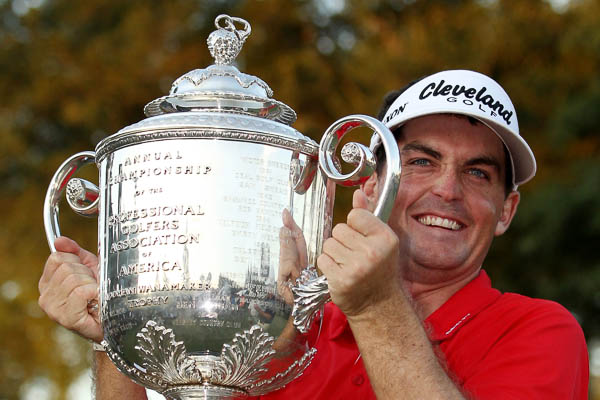
Keegan Bradley, a graduate of the NGA Hooters Tour, won the 2011 PGA Championship and is one of the Tour’s best success stories.
And now that the Q-School has been revised to replenish the roster of the Web.com Tour, expect more players to take up a path of apprenticeship that could meander through the Pepsi Tour, over to the Peach State Professional Golf Tour, and everything in-between. With more than 60 tours in operation world-wide, the prevailing wisdom ought to be play hard and pack light.
So You Want To Run A Mini Tour?
Jeff Flees used to manage a mortgage firm in Worthington, Ohio. But his wife’s protracted health concerns led him to reevaluate his career prospects. Nowadays, he’s the president of a three-person operation that runs the nascent Flagship Golf Tour.
“I had a successful career in the mortgage banking industry for 16 years, however in 2011 my wife had two major surgeries, one of which was brain surgery to clip aneurysms she had been living with,” says Flees. “My wife is one of the most incredible, inspirational people you will ever meet or know. I felt it was important to take time off to be with her while she recovered. When the time was right, my passion for golf and experience with people in the industry led my to analyze the developmental tour business and start the Flagship Golf Tour.”
The first scheduled event will be played this summer at The Journey at Pechanga in Temecula, Calif. The single day, 18-hole stroke play championship will feature a $5,000 purse and will benefit a number of charities including the Brain Aneurysm Foundation. The entry fee for professionals is $300 ($200 for amateurs) and unlike many higher profile tours, there is no annual membership fee.
For those of us who have never played golf for a living, taking up membership on a mini tour is a significant expense when combined with standard tournament fees and general travel expenses. Existing tours with deep fields and decent purses can charge $1,000 or more for membership. That will help you get a bona fide member packet, a tour hat and access to practice facilities at host courses. To actually play in a tournament event, you’ll likely drop close to another $1,000. A single season on the NGA Hooters’ 2013 Carolina Series will run a pro golfer a little over $10,000 in fees (depending on whether or not they have pre-existing status on the tour). Sounds almost reasonable until you start factoring things like groceries and gas money, or taking a date out to a dinner and a movie.
By contrast, there’s next to no risk to play a Flagship Golf Tour event and the tour awards prize money to the top 33 percent of the field, which is consistent with the policy maintained by more established entities. The tour does differ significantly from many competitors in that tournament events are spread out nationally and a champion is crowned after 18 holes.
“We decided on the one-day 18-hole tournaments because they make more logistical and financial sense,” says Flees. “The benefit of a one-day, 18-hole event is that we can keep the expenses down and reduce the time commitment for everyone involved in the tournament. We respect what the more established tours are doing. We are not trying to directly compete with them.”
Whether the Flagship Golf Tour finds its niche and succeeds beyond the first couple of seasons is difficult to predict. The term “boom and bust” is often used to describe mini tours that have disappeared after some initial success. Not surprisingly, the pressure to succeed falls squarely on a busy owner’s shoulders. You’re expected to be equally adept at playing the role of savvy business manager and gregarious promoter. Some days call for negotiating contracts with vendors and sponsors. Other days you’ll be rubbing elbows with potential investors or stumping on behalf of your tour around the clock on Twitter.
For many business executives, running a mini tour is a labor of love (not to mention an expensive hobby).
Alex Spanos had a brief run lending his name to one of the preeminent developmental tours on the West Coast before scuttling the business after three years. Spanos was a scratch golfer in his youth and made his fortune in the construction services industry. He is better known for owning a majority stake in the San Diego Chargers football team.
Full field events on the Spanos California Tour featured sizable purses including a $250,000 cash grab called the A.G. Spanos California Open. Local boys Jason Gore, John Merrick and Peter Tomasulo had stints on the tour before moving on to play much bigger venues.
“I have always wanted to be part of a golf tour,” Spanos was quoted as saying. “My goal with this tour is to have it become the biggest and best in this state, if not the country, where young professionals and amateurs get the opportunity to show their talent and ability.”
Even in its final year of operation, the California Tour was arguably still growing. The tour signed Ameriquest Mortgage Company as a presenting sponsor, hired a San Diego area public relations firm to raise brand awareness, increased the number of events to 16 and set aside $2.5 million in available winnings. But they shut the tour down anyway. Perhaps that was the intention all along.
According to executives associated with Spanos, running the tour had become prohibitively expensive. It also didn’t help that a far more expansive developmental tour made a glitzy splash in 2006, promising tournament winnings to rival the PGA Tour.
Backed by the now defunct Greens Worldwide Inc., the U.S. Pro Golf Tour was expected to offer $300,000 for a standard event and as much as $5 million for one of its majors that would be played on a Donald Trump-owed course and broadcast on television by ESPN. There were rumblings about impending doom from the start and the tour folded after the initial season. In the process, the U.S. Pro Golf Tour defrauded hundreds of golfers who forked over thousands of dollars to participate in events that were never going to be staged.
As any professional golfer who has scrambled on the mini tours can tell you, there are plenty of similar misadventures that players have fallen victim to. Most of them are simply too obscure to grab the public’s attention, even within golfing circles. And in some ways, it’s a perverse right of passage.
The (Not So) Charmed Life Of A Professional Golfer
More than likely, you haven’t heard of Andrew Jensen. He’s just another golfer playing on the PGA Tour of Canada who’s had scrapes with success, failure, injuries and heartbreak. But I’m getting ahead of myself.
We pick up his story in March. Jensen has driven down to Florida, as far south from frigid Ottawa as his Pontiac G6 will take him. He intends to spend a month living in the Sarasota area getting into shape for a season that will play out primarily back in Canada. Except that the weather in Florida, in fact for much of the southern United States, isn’t living up to expectations.
Too many mornings in the Sunshine State start off borderline freezing; as for Jensen’s game, it’s not a whole lot better. In his first competitive event of the season, he shoots 2-over and misses the cut. Over the next several weeks his game starts trending in the right direction. He records his best finish on the Florida swing at TPC Prestancia in Sarasota. It’s a limited-field event of 28 participants playing for a purse that barely covers rent for a single-bedroom apartment on Manhattan’s Upper West Side.
Jensen has an opportunity to finish 2-under on the first day, but rinses two balls on the last hole for an ugly double. He plays marginally worse the next day, making three straight bogies on the front nine, carding a 75 and finishing three strokes outside of earning a paycheck.
Three events come and go and all Jensen has to show for it some middling scores. It’s a good blow to one’s wallet (and psyche), but Jensen has developed some thick skin over the years. He’s been playing professionally off and on since 2008. He’s taken time off to heal from injuries and to recover from periodic episodes of depression. And while it may be difficult to spin positives from his Florida swing based on scoring alone, Jensen is grateful to be playing golf regularly again.
“When I was playing injured in 2010 and playing bad . . . the debt was increasing fast,” says Jensen. “Golf was no longer fun, it was work, it was gambling to break even. My passion for the game left me very quickly but I tried to tough it out and keep playing regardless. That mentality bled into two awful seasons on tour and my eventual hanging up the clubs in 2011 to enter into the real world and start working and getting above water financially. Luckily, over time the passion came back.”
Jensen played competitively for the University of Ottawa and qualified to play for the Canadian Tour the year following his graduation in 2007. Although some golfers would have journeyed south to play in more seasonably warm conditions year-round, Jensen preferred to stay closer to home, not all that surprising for a person who habitually found comfort in maintaining rigorous routine.
Unfortunately, there was very little in the way of predictability to his first three seasons on tour. Jensen made the cut just twice in 14 events in 2008, making $870. He earned another $3,100 on the tour in 2010-11 and watched his confidence fade as debts rose.
“When you can solely focus on the routine and the process, good play takes care of itself,” says Jensen. “When you have to figure out a way to pay the bills, it takes away from your routine. Over the years, my play has struggled and consequently my funds have depleted, forcing me into off-season work in Canada over the winters. The routine has to switch to fitness, indoor practice, mental work, and above all a ‘real job.’”
His outlook rapidly declined in 2011. A family physician prescribed an anti-depressant medication that had an unintended side-effect of actually increasing suicidal urgings. Standing over a bathroom sink with a mouth full of anti-depressant pills, Jensen nearly took his life that September. Fortunately he spat the medication out and was weened off the anti-depressant a few weeks later. Through therapy, Jensen came to regard golf as a trigger for his mental issues.
“Every time I played poorly, it just kept getting worse and worse emotionally,” Jensen told the Ottawa Citizen in 2012.
Jensen isn’t the only golfer who has struggled with depression. The LPGA Tour’s Christina Kim was openly forthcoming about her own personal struggles in an interview with Golf Digest. Still, there aren’t many golfers, let alone athletes in general, that are willing to go public. It is habitually accepted that athletes need to maintain an edge over their competition. And nothing blows an athlete’s cover faster than revealing they have fears and doubts.
“The numbers on depression are staggering, it affects far more people than many believe,” says Jensen. “The pressure, isolation and competition in professional golf are massive triggers to get players down on themselves both on and off the course. From my experiences with mental illness it’s a hard road to play golf and keep things silent. The minute I came out with my struggles, the support and solidarity that came from fellow players was great. No one knows the struggles of a mini tour player better than a fellow mini tour player.”
Historically, the various developmental tours have left players to their own devices. Some tours offer discounts on sponsor-provided apparel and equipment, but rarely is sports psychology factored into any of the few membership perks enjoyed on tour. By offering player coaching from the outset, the Flagship Golf Tour is looking to differentiate itself even further from its more established competitors.
“We are working with excellent professionals who can offer our players guidance in these areas,” says Flees. “The players will get initial information and coaching made available to them free of charge, however if they wish to retain these professionals for additional assistance there would be a charge.”
The Flagship Golf Tour has developed a relationship with David Donatucci, a Titelist Performance Institute certified trainer a member of the PGA of America, as well as PGA member Rick Sessinghaus, a proven sports psychologist. It will be interesting to see how many players actually seek out coaching and if it spurs other developmental tours to consider similar service offerings in the future.
As Jensen can tell you from experience, playing on the mini tours is a grind. Reflecting on the past five years as a golf pro, Jensen says, “[The mini tours haven’t] taught me too much about golf itself, apart from the reality that making putts is everything. It’s taught me that I am very determined and driven, easily discouraged at times, but still very motivated. Hard work for five years really hasn’t gotten me too far in this game so I’ve learned I need to work smarter now.”
A Long And Winding Road
Imagine you’re 16 years old, living by yourself in California. Your preternatural golfing abilities land you a future spot on the University of Oklahoma golf team. Your stellar college play gets noticed and you make the Walker Cup team. After three years you leave school early and declare your intentions to turn pro. You receive a sponsor’s exemption into your first PGA Tour event and you finish runner up. A year later you earn tour card in your first go-around at Q-School and ultimately become a multimillionaire before the age of 22.
It’s almost a lock that most golfing careers will not pan out like Anthony Kim’s supercharged ascent to stardom. With any luck, you might be fortunate enough mimic James Hahn, who clawed his way onto the PGA Tour after spending nine years playing on the mini tours and supplementing his income selling ladies shoes at Nordstrom’s.
So if you are a talented golfer, what exactly are your chances?
In an unrelated sport, the NCAA has compiled statistics on the number of high school basketball players who continue to play professionally after graduating from college. Of the roughly 156,000 high school seniors who play basketball, 44 will be drafted into the NBA. Even at less than 1 percent, a basketball player has a better chance of filling one of the 350 or so roster spots in the NBA than a golfer has of sharing a fairway with Phil Mickelson.
Andrew Jensen doesn’t believe that a talent gap is keeping most mini tour players from propelling themselves to the next level.
“I think it has more to do with the off course hurdles than the competition,” says Jensen. “I’ve seen many great players pack it in because of their financial situation, the travel, or the time away from family, just to name a few reasons. I don’t believe players stop because they don’t think they have what it takes.”
There are thousands of golfers playing on the mini tours every year. What happens to the ones that don’t make it?
Perhaps some of them get a taste of success at the higher reaches of golf and regress. Others washout after only a few seasons on the road. Some quit playing and take up teaching while others quit the game entirely.
In spite of what is easily construed as abject failure, any player who has made it as far as the mini tours has an experience with the game that few golfers rarely come in contact with. It may not be the sort of ending that a Hollywood producer would dream up. But as golf announcer Gary Koch famously quipped, it’s better than most.
- LIKE79
- LEGIT14
- WOW6
- LOL0
- IDHT0
- FLOP0
- OB0
- SHANK0
19th Hole
Vincenzi’s 2024 Zurich Classic of New Orleans betting preview

The PGA TOUR heads to New Orleans to play the 2023 Zurich Classic of New Orleans. In a welcome change from the usual stroke play, the Zurich Classic is a team event. On Thursday and Saturday, the teams play best ball, and on Friday and Sunday the teams play alternate shot.
TPC Louisiana is a par 72 that measures 7,425 yards. The course features some short par 4s and plenty of water and bunkers, which makes for a lot of exciting risk/reward scenarios for competitors. Pete Dye designed the course in 2004 specifically for the Zurich Classic, although the event didn’t make its debut until 2007 because of Hurricane Katrina.
Coming off of the Masters and a signature event in consecutive weeks, the field this week is a step down, and understandably so. Many of the world’s top players will be using this time to rest after a busy stretch.
However, there are some interesting teams this season with some stars making surprise appearances in the team event. Some notable teams include Patrick Cantlay and Xander Schauffele, Rory McIlroy and Shane Lowry, Collin Morikawa and Kurt Kitayama, Will Zalatoris and Sahith Theegala as well as a few Canadian teams, Nick Taylor and Adam Hadwin and Taylor Pendrith and Corey Conners.
Past Winners at TPC Louisiana
- 2023: Riley/Hardy (-30)
- 2022: Cantlay/Schauffele (-29)
- 2021: Leishman/Smith (-20)
- 2019: Palmer/Rahm (-26)
- 2018: Horschel/Piercy (-22)
- 2017: Blixt/Smith (-27)
2024 Zurich Classic of New Orleans Picks
Tom Hoge/Maverick McNealy +2500 (DraftKings)
Tom Hoge is coming off of a solid T18 finish at the RBC Heritage and finished T13 at last year’s Zurich Classic alongside Harris English.
This season, Hoge is having one of his best years on Tour in terms of Strokes Gained: Approach. In his last 24 rounds, the only player to top him on the category is Scottie Scheffler. Hoge has been solid on Pete Dye designs, ranking 28th in the field over his past 36 rounds.
McNealy is also having a solid season. He’s finished T6 at the Waste Management Phoenix Open and T9 at the PLAYERS Championship. He recently started working with world renowned swing coach, Butch Harmon, and its seemingly paid dividends in 2024.
Keith Mitchell/Joel Dahmen +4000 (DraftKings)
Keith Mitchell is having a fantastic season, finishing in the top-20 of five of his past seven starts on Tour. Most recently, Mitchell finished T14 at the Valero Texas Open and gained a whopping 6.0 strokes off the tee. He finished 6th at last year’s Zurich Classic.
Joel Dahmen is having a resurgent year and has been dialed in with his irons. He also has a T11 finish at the PLAYERS Championship at TPC Sawgrass which is another Pete Dye track. With Mitchell’s length and Dahmen’s ability to put it close with his short irons, the Mitchell/Dahmen combination will be dangerous this week.
Taylor Moore/Matt NeSmith +6500 (DraftKings)
Taylor Moore has quickly developed into one of the more consistent players on Tour. He’s finished in the top-20 in three of his past four starts, including a very impressive showing at The Masters, finishing T20. He’s also finished T4 at this event in consecutive seasons alongside Matt NeSmith.
NeSmith isn’t having a great 2024, but has seemed to elevate his game in this format. He finished T26 at Pete Dye’s TPC Sawgrass, which gives the 30-year-old something to build off of. NeSmith is also a great putter on Bermudagrass, which could help elevate Moore’s ball striking prowess.
- LIKE6
- LEGIT2
- WOW1
- LOL0
- IDHT0
- FLOP3
- OB1
- SHANK1
19th Hole
Vincenzi’s 2024 LIV Adelaide betting preview: Cam Smith ready for big week down under

After having four of the top twelve players on the leaderboard at The Masters, LIV Golf is set for their fifth event of the season: LIV Adelaide.
For both LIV fans and golf fans in Australia, LIV Adelaide is one of the most anticipated events of the year. With 35,000 people expected to attend each day of the tournament, the Grange Golf Club will be crawling with fans who are passionate about the sport of golf. The 12th hole, better known as “the watering hole”, is sure to have the rowdiest of the fans cheering after a long day of drinking some Leishman Lager.
The Grange Golf Club is a par-72 that measures 6,946 yards. The course features minimal resistance, as golfers went extremely low last season. In 2023, Talor Gooch shot consecutive rounds of 62 on Thursday and Friday, giving himself a gigantic cushion heading into championship Sunday. Things got tight for a while, but in the end, the Oklahoma State product was able to hold off The Crushers’ Anirban Lahiri for a three-shot victory.
The Four Aces won the team competition with the Range Goats finishing second.
*All Images Courtesy of LIV Golf*
Past Winners at LIV Adelaide
- 2023: Talor Gooch (-19)
Stat Leaders Through LIV Miami
Green in Regulation
- Richard Bland
- Jon Rahm
- Paul Casey
Fairways Hit
- Abraham Ancer
- Graeme McDowell
- Henrik Stenson
Driving Distance
- Bryson DeChambeau
- Joaquin Niemann
- Dean Burmester
Putting
- Cameron Smith
- Louis Oosthuizen
- Matt Jones
2024 LIV Adelaide Picks
Cameron Smith +1400 (DraftKings)
When I pulled up the odds for LIV Adelaide, I was more than a little surprised to see multiple golfers listed ahead of Cameron Smith on the betting board. A few starts ago, Cam finished runner-up at LIV Hong Kong, which is a golf course that absolutely suits his eye. Augusta National in another course that Smith could roll out of bed and finish in the top-ten at, and he did so two weeks ago at The Masters, finishing T6.
At Augusta, he gained strokes on the field on approach, off the tee (slightly), and of course, around the green and putting. Smith able to get in the mix at a major championship despite coming into the week feeling under the weather tells me that his game is once again rounding into form.
The Grange Golf Club is another course that undoubtedly suits the Australian. Smith is obviously incredibly comfortable playing in front of the Aussie faithful and has won three Australian PGA Championship’s. The course is very short and will allow Smith to play conservative off the tee, mitigating his most glaring weakness. With birdies available all over the golf course, there’s a chance the event turns into a putting contest, and there’s no one on the planet I’d rather have in one of those than Cam Smith.

Louis Oosthuizen +2200 (DraftKings)
Louis Oosthuizen has simply been one of the best players on LIV in the 2024 seas0n. The South African has finished in the top-10 on the LIV leaderboard in three of his five starts, with his best coming in Jeddah, where he finished T2. Perhaps more impressively, Oosthuizen finished T7 at LIV Miami, which took place at Doral’s “Blue Monster”, an absolutely massive golf course. Given that Louis is on the shorter side in terms of distance off the tee, his ability to play well in Miami shows how dialed he is with the irons this season.
In addition to the LIV finishes, Oosthuizen won back-to-back starts on the DP World Tour in December at the Alfred Dunhill Championship and the Mauritus Open. He also finished runner-up at the end of February in the International Series Oman. The 41-year-old has been one of the most consistent performers of 2024, regardless of tour.
For the season, Louis ranks 4th on LIV in birdies made, T9 in fairways hit and first in putting. He ranks 32nd in driving distance, but that won’t be an issue at this short course. Last season, he finished T11 at the event, but was in decent position going into the final round but fell back after shooting 70 while the rest of the field went low. This season, Oosthuizen comes into the event in peak form, and the course should be a perfect fit for his smooth swing and hot putter this week.

- LIKE10
- LEGIT3
- WOW0
- LOL1
- IDHT0
- FLOP1
- OB1
- SHANK1
Opinion & Analysis
The Wedge Guy: What really makes a wedge work? Part 1

Of all the clubs in our bags, wedges are almost always the simplest in construction and, therefore, the easiest to analyze what might make one work differently from another if you know what to look for.
Wedges are a lot less mysterious than drivers, of course, as the major brands are working with a lot of “pixie dust” inside these modern marvels. That’s carrying over more to irons now, with so many new models featuring internal multi-material technologies, and almost all of them having a “badge” or insert in the back to allow more complex graphics while hiding the actual distribution of mass.
But when it comes to wedges, most on the market today are still single pieces of molded steel, either cast or forged into that shape. So, if you look closely at where the mass is distributed, it’s pretty clear how that wedge is going to perform.
To start, because of their wider soles, the majority of the mass of almost any wedge is along the bottom third of the clubhead. So, the best wedge shots are always those hit between the 2nd and 5th grooves so that more mass is directly behind that impact. Elite tour professionals practice incessantly to learn to do that consistently, wearing out a spot about the size of a penny right there. If impact moves higher than that, the face is dramatically thinner, so smash factor is compromised significantly, which reduces the overall distance the ball will fly.
Every one of us, tour players included, knows that maddening shot that we feel a bit high on the face and it doesn’t go anywhere, it’s not your fault.
If your wedges show a wear pattern the size of a silver dollar, and centered above the 3rd or 4th groove, you are not getting anywhere near the same performance from shot to shot. Robot testing proves impact even two to three grooves higher in the face can cause distance loss of up to 35 to 55 feet with modern ‘tour design’ wedges.
In addition, as impact moves above the center of mass, the golf club principle of gear effect causes the ball to fly higher with less spin. Think of modern drivers for a minute. The “holy grail” of driving is high launch and low spin, and the driver engineers are pulling out all stops to get the mass as low in the clubhead as possible to optimize this combination.
Where is all the mass in your wedges? Low. So, disregarding the higher lofts, wedges “want” to launch the ball high with low spin – exactly the opposite of what good wedge play requires penetrating ball flight with high spin.
While almost all major brand wedges have begun putting a tiny bit more thickness in the top portion of the clubhead, conventional and modern ‘tour design’ wedges perform pretty much like they always have. Elite players learn to hit those crisp, spinny penetrating wedge shots by spending lots of practice time learning to consistently make contact low in the face.
So, what about grooves and face texture?
Grooves on any club can only do so much, and no one has any material advantage here. The USGA tightly defines what we manufacturers can do with grooves and face texture, and modern manufacturing techniques allow all of us to push those limits ever closer. And we all do. End of story.
Then there’s the topic of bounce and grinds, the most complex and confusing part of the wedge formula. Many top brands offer a complex array of sole configurations, all of them admittedly specialized to a particular kind of lie or turf conditions, and/or a particular divot pattern.
But if you don’t play the same turf all the time, and make the same size divot on every swing, how would you ever figure this out?
The only way is to take any wedge you are considering and play it a few rounds, hitting all the shots you face and observing the results. There’s simply no other way.
So, hopefully this will inspire a lively conversation in our comments section, and I’ll chime in to answer any questions you might have.
And next week, I’ll dive into the rest of the wedge formula. Yes, shafts, grips and specifications are essential, too.
- LIKE32
- LEGIT7
- WOW1
- LOL1
- IDHT2
- FLOP3
- OB1
- SHANK3
-

 19th Hole2 weeks ago
19th Hole2 weeks agoDave Portnoy places monstrous outright bet for the 2024 Masters
-

 19th Hole2 weeks ago
19th Hole2 weeks agoTiger Woods arrives at 2024 Masters equipped with a putter that may surprise you
-

 19th Hole1 day ago
19th Hole1 day ago‘Absolutely crazy’ – Major champ lays into Patrick Cantlay over his decision on final hole of RBC Heritage
-

 19th Hole3 weeks ago
19th Hole3 weeks agoReport: Tiger Woods has ‘eliminated sex’ in preparation for the 2024 Masters
-

 19th Hole1 week ago
19th Hole1 week agoTwo star names reportedly blanked Jon Rahm all week at the Masters
-

 19th Hole1 week ago
19th Hole1 week agoReport: LIV Golf identifies latest star name they hope to sign to breakaway tour
-

 19th Hole1 week ago
19th Hole1 week agoNeal Shipley presser ends in awkward fashion after reporter claims Tiger handed him note on 8th fairway
-

 19th Hole1 day ago
19th Hole1 day agoJustin Thomas on the equipment choice of Scottie Scheffler that he thinks is ‘weird’

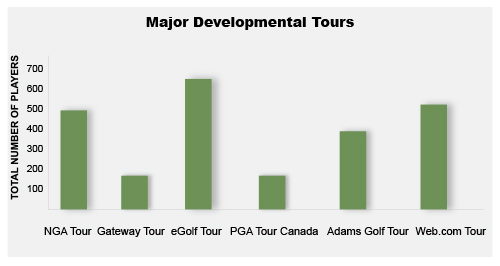
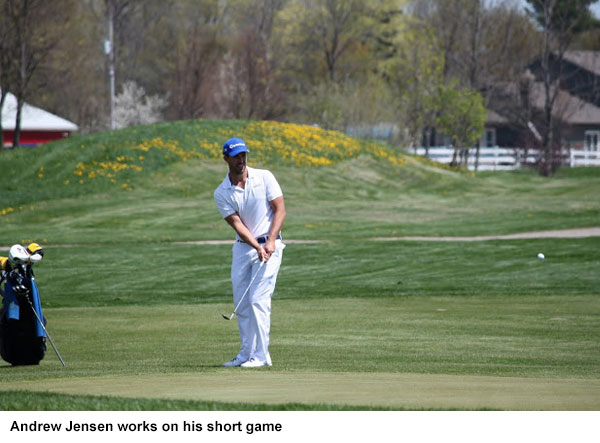
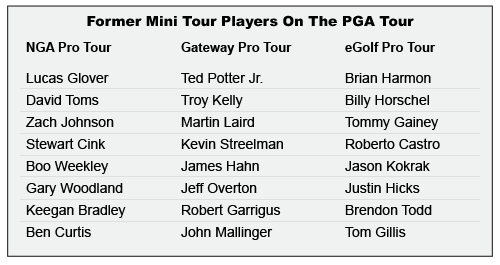


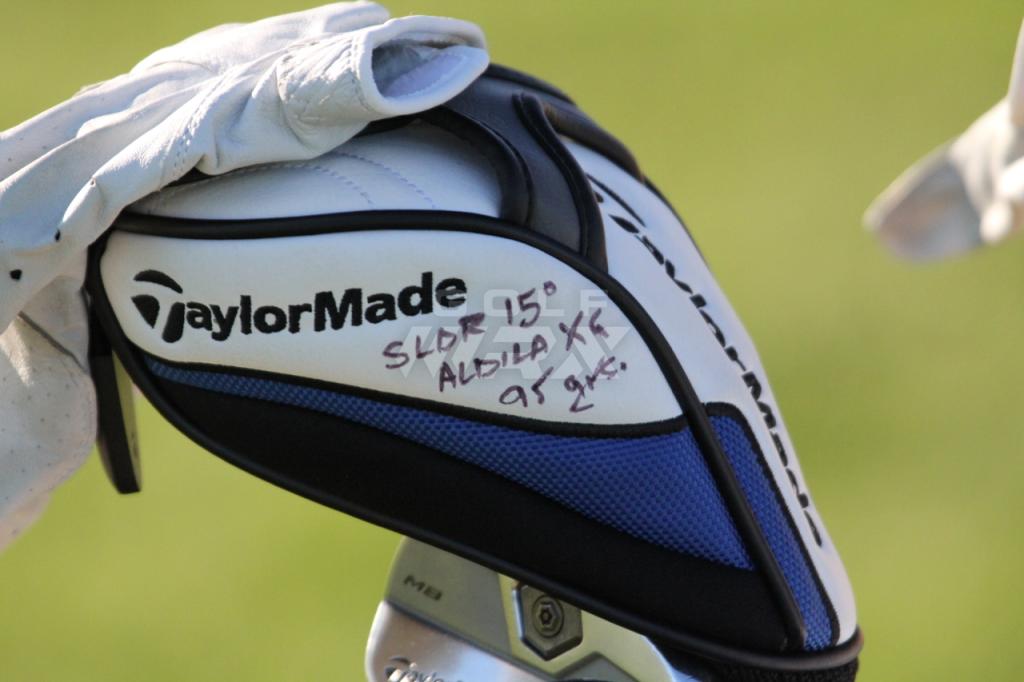

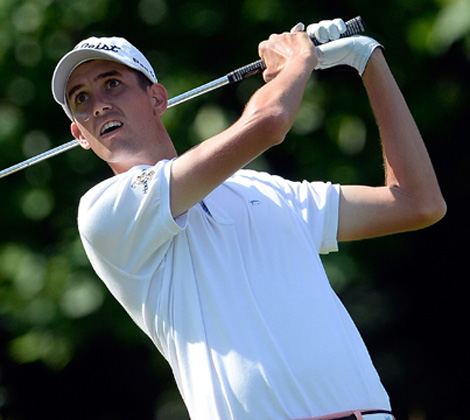


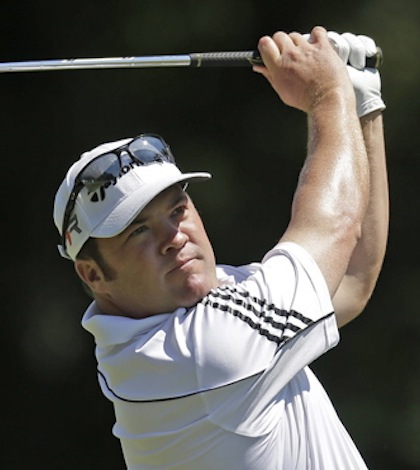












Mike Boatright
Jan 23, 2017 at 4:31 pm
Iv’e researched heavily these mini tours and have found the leaders to have a scoring average of say 65.66 etc.. The pga tour needs to get off it’s elitists ass and give these good players a legitimate chance! Any time you set up a format that requires you to either have a sponsor exemption or play great for 6 days straight just to make it on the minor leagues is kinda making it far fetched for the majority of good players who aren’t rich. They do have some monday qualifying events which is just a blood fest first you need to pre qualify to make it into the qualifier which is you vs 4 guys usually a 65 loses and a 64 wins,then you qualify for the monday and it’s the same story you shoot 67 on a windy day the other guy shoots 66. By then the winner is so tired and nervous from his start that he shoots 75 70 and misses the cut by one stroke how is this fair?
adam
Jul 25, 2014 at 9:01 pm
Listen, if you’re good enough you will sail through Web.com Q School and be on that AAA tour. If you’re good enough there, you’ll be on the PGA tour. Much easier today. Web.com Q school doesn’t care if you went to Stanford or Truckee Meadows Community College.
jess robinson
Jun 7, 2013 at 12:31 pm
“Golf is happiness for
Happiness is achievement.
The father of achievement is motivation
The mother is encouragement.
The fine golf swing is truly achievement
Man may lie, cheat, and steal for gain.
But, these will never gain the golf swing
To gain the golf swing man must work.
Yet it is work without toil
It is exercise without the boredom.
It is intoxication without the hangover
It is stimulation without the pills.
It is failure yet its successes shine even more brightly
It is frustration yet it nourishes patience.
It irritates yet its soothing is far greater
It is futility yet it nurtures hope.
It is defeating yet it generates courage
It is humbling yet it ennobles the human spirit.
It is dignity yet it rejects arrogance
Its price is high yet its rewards are richer
Some say it’s a boy’s pastime yet it builds men
It is a buffer for the stresses of today’s living.
It cleanses the mind and rejuvenates the body
It is these things and many more.
For those of us who know it and love it
Golf is truly happiness.”
— Paul Bertholy
Frank Dolan
May 19, 2013 at 6:48 pm
Most authors make mistakes, specifically for those readers who look for mistakes. If you look past the mistakes, you will really enjoy the article. Another home run for you Mr. Cage. Keep those articles coming – I enjoy them tremendously.
P. S. – Did I make any grammatical errors?
youstink
May 11, 2013 at 7:43 pm
I never want to chase a dream. I just want to go to my 9-5 job and sit in my cubical all day and grind my teeth over the fact my wife is probably banging the pool guy that I pay with the money I saved from my boring conservative life…
When the day ends I want to put myself to sleep by correcting Blog articles on a golf website full of folks that can’t appreciate truthful information because they think they know everything…
Sean
May 10, 2013 at 4:36 pm
I enjoyed the article. There are a few segments I can relate to as well.
Steve Pratt
May 10, 2013 at 1:53 am
I thought this was a terrific article. It brought back good and bad memories of my experiences on various mini tours.
In my opinion, the author nicely captures the essence of life and struggles on the mini tours.
Danny
May 9, 2013 at 7:54 pm
Ian poulter will be broke and infamous in 10 years. They guy never wins except for the Ryder Cup which doesn’t pay. Normally the guys that got it dont flaunt it, and the ones that flaunt it don’t have it. Look at Warren Buffet compared to Donlad Trump. Trump has been bankrupt several times and sues publications that post his real worth which is about 1/10th what he says it is.
Curt
May 10, 2013 at 12:22 am
Donald Trump just inquired about your physical address, so he coulde serve you!!! Dont answer the door!!!
Shawn
May 10, 2013 at 11:20 am
I think you’ll find that a lot of successful people have had bankruptcies in their past. That line of reasoning doesn’t make a lot of sense. Trump’s liquid worth is far less than his worth on paper, but that’s a pretty common thing for people who own a lot of stuff, rather than have a lot of money.
I’m no Poulter fan, but he seems to have an awful lot of cash for a guy that never wins.
sdgfhjkhgjkdfsfg
May 9, 2013 at 7:15 pm
the best line in the article:
“But for every Ian Poulter who owns a fleet of Ferraris and struts around like a movie star, ”
Ian is a new money brat. It’s amazing how much that guy brags.
Dave
May 10, 2013 at 10:12 am
If there was one player I could punch in the face it would no doubt be IJP. By the way, the logo for his clothing line is ABSOLUTELY TERRIBLE… what designers is this guy hiring!?
Tool Status
May 9, 2013 at 4:09 pm
id probably tear up one of these mini tours, but id rather just spend my time with the ladies
gorgor
May 11, 2013 at 10:17 pm
+! internet
danny
May 9, 2013 at 3:51 pm
I blame these guy’s parents. There comes a time in everyone’s life when you can’t chase your dreams any longer. Sometimes we can’t see it ourselves and the worst thing you can have is parents and loved ones feeding in to that dream. I had a sister who wanted to be a doctor in the worst way but couldn’t get in to med school. I also had a roommate who longed to be a fighter pilot, yet didn’t have great eye sight. Both of these people were told by loved ones that it’s time to grow up and move on, and both are living happy lives because of it now. It takes a real man to admit when enough is enough and it’s time to move on.
Nick
May 9, 2013 at 9:12 pm
Why Should anyone give up on their dreams ever? You only get one shot at life, do what makes you happy and forget the “realists”. They will be the ones wondering what if and saying I should have when they are too old to live thier dreams. At least you spent your life working 9-5, for whatever that is worth…
Danny
May 9, 2013 at 10:55 pm
It’s selfish. These dreamers will end up with debt and families to pass it on to.
tsunamijohn
May 9, 2013 at 3:35 pm
Question nothing, just drink the Kool-Aid.
Minitourplayer
May 9, 2013 at 2:56 pm
So did the Flagship Tour pay for this article?
Zak Kozuchowski
May 9, 2013 at 3:27 pm
Minitourplayer,
Rusty is a wonderful writer with strong journalism instincts and morals. For you to suggest otherwise shows that you haven’t paid much attention to his previous work, or the GolfWRX Featured Writers program as a whole.
– Zak
t120
May 9, 2013 at 8:34 pm
That…is your opinion, Zak.
I think it goes beyond sounding like an ad, but well-written? I wouldn’t go that far. It’s a few different “HARO” respondents he aggregated into an ambling, unclear rough draft of article. A good journalist doesn’t just take notes and format, he tells a captivating story.
What did he do instead?
1.) He spent a large portion of the article covering a mini-tour that hasn’t yet played a game.
2.) Profiled a Canadian golfer that briefly played in Canada, not U.S. Mini tours.
3.) Dropped a few names of past mini-tour players, yet didn’t expand on them.
4.) Threw in some generalizations about past tour players that may or may not have existed, been scratch golfers, and/or quit for up to 5 various reasons unrelated to their game. Not a single name, or proof backing up that theory.
All of that and I still have no idea what the Hooters, Pepsi or any other mini tour is really like. Maybe interview someone that’s actually been on one or more of the major tours and get a first hand account.
As it stands, if you read this article the only thing you’ll get out of it is “Guys. Even if you’re very, very good, if you can’t afford a nice round number like $10,000/yr – you will be forced to sell shoes at Nordstrom.”
tim roncone
May 10, 2013 at 1:13 am
when you choose to find a negative in something you will always fail to see the good or in this case understand whats he’s trying to portray. i really hope you have better things to do with your life than bash other peoples work. have a nice day tool.
t120
May 10, 2013 at 11:46 pm
So…your response is somehow vindicated because I didn’t write an article? Who’s really the tool here? You didn’t bring anything to the table but a comment about a comment and in total frustration with your inability to make a point – a condescending remark.
Minitourplayer
May 10, 2013 at 9:55 am
Its basically a commercial for a brand new tour that no one has heard of
Dave
May 10, 2013 at 10:09 am
I disagree… I clicked on the article thinking it would in fact be a story about life as a mini-tour player and instead it was disjointed and unrelatable. It’s a shame.
On another note, I find it hard to believe that there are only 156,000 HS seniors playing basketball each year, but who knows.
Shawn
May 10, 2013 at 11:18 am
I completely agree with you. Between the headline that feels kind of misleading, a lot of Typos (“There’s” as was mentioned above and a few other awkward choices) I don’t think this is a very good article at all.
x-15a2
May 9, 2013 at 2:13 pm
The word “there’s” is a contraction for “there is”. That being the case, you’d never write “there is plenty of golfers…”, “there is thousands who don’t.” or “There is thousands of golfers playing on the mini tours every year.” In these cases, you would say “there are” instead of “there is”. For the record, “…there’s next to no risk to play a Flagship Golf Tour event” is the correct use of “there’s”.
The contraction that you are looking for “there are” is “there’re” but besides being difficult to pronounce, “there’re” looks peculiar (and is incorrectly rejected by many spell-checkers). You are probably better off ditching a contraction for “there are”.
Joey5Picks
May 15, 2013 at 3:47 pm
That was a fun post to read. Thanks for the puncuation lesson.